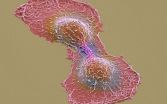How female flies know when to say 'yes'
2014-10-07
(Press-News.org) A fundamental question in neurobiology is how animals, including humans, make decisions. A new study publishing in the open access journal PLOS Biology on October 7 reveals how fruit fly females make a very important decision: to either accept or reject male courtship. This decision appears to be generated by a very small number of excitatory neurons that use acetylcholine as their neurotransmitter located in three brain regions. This study provides the framework to understand how decisions are generated and suggests that a decision is reached because that option is literally the most exciting.
In choosing mates, females select traits that they like, which will be inherited by their offspring. Because the chosen traits will likely be displayed by following generations, mate choice is central to both the conservation and diversification of species, and, thus, partially responsible for the great variety of organisms on earth. However, despite how important mate choice is, the genes, cells, and circuits that are required to make such a decision remain largely unknown. To investigate this problem, the authors turned to the brain of fruit flies. Flies are posed, as every other animal on Earth, with daily situations in which they have to make a decision (Should I approach that ripe banana?). In addition, as with the human brain, the fly brain is compartmentalized into regions that process different sensory information (visual, acoustic, olfactory), and it uses the same types of neurotransmitters as humans. Therefore, a fly brain is a good model for studying decision-making.
To tease apart how neurons make a decision, the authors took a genetic approach: they searched for genes that control mate choice. They found one gene that, when mutated, rendered the female flies incapable of deciding whether to mate or not. "This gene, named dati, was hiding in one the most genetically inaccessible regions of the genome" says Dr. Rui Sousa-Neves from the Department of Genetics and Genome Sciences of Case Western Reserve University, the senior author of the publication. "What is so remarkable about dati is that females that are mutant for just this single gene can never decide to accept males, no matter how hard the males try to impress them" says Joseph Schinaman, a PhD student and first author of the publication. Normally, fruit fly females decide whether or not to mate within 15 minutes of a male courting them by dancing, singing (with their wings), and releasing pheromones. If the male has not succeeded after 30 minutes of courtship, it is certain to fail.
The authors went on to determine where, spatially, this gene acted to influence courtship acceptance of the female fly. To test that, the authors reduced dati expression in different tissues using a technology called RNA interference (RNAi) and found it to be required in the nervous system, in cholinergic neurons. "This was a very exciting moment and we wanted to know where these neurons were located in the brain" says Dr. Sousa-Neves. To solve this problem, the authors developed a genetic system to generate small patches of neurons lacking dati in an otherwise normal brain. To visualize the brain locations of these patches, they engineered the dati lacking mutant cells to express a green fluorescent protein. The authors systematically analyzed a large number of flies in which different patches of neurons lacked dati, and were able to map the rejection behavior to three distinct regions in the brain, two of which had never been previously associated with mating behavior. They narrowed the circuit down even further by determining which neurons in these brain regions both expressed dati and were cholinergic. To their great surprise they found that a mere 15 cells in two of the regions, and as few as 4 in the third region, were capable of producing mating rejection behavior. "It is remarkable that such a complex behavior could be generated from such a small number of neurons" says Dr. Sousa-Neves. "Our results provided a molecular and cellular basis of a hypothesis elaborated more than 50 years ago on how fruit fly females accept males", says Dr. Claudia M. Mizutani, one of the collaborators in this study, from the Biology Department of Case Western Reserve University. Dr. Sousa-Neves explains that this hypothesis, known as "summation hypothesis", predicts that females integrate, or summate, all types of sensory information given by male courtship in order to reach a state of excitement that, according to this study, seems to be provided by a small number of excitatory neurons arranged in a circuit that projects to main sensory centers in the brain. "This gives us quite an exciting springboard to fully map out this decision-making circuit from all the sensory inputs leading into the brain and how the brain parses and compares these signals, and comes to a decision," states Schinaman.
INFORMATION:
Please mention PLOS Biology as the source for this article and include the links below in your coverage to take readers to the online, open access articles
All works published in PLOS Biology are open access, which means that everything is immediately and freely available. Use this URL in your coverage to provide readers access to the paper upon publication:
http://www.plosbiology.org/article/info:doi/10.1371/journal.pbio.1001964
Contact
Dr. Rui Sousa-Neves
Department of Genetics and Genome Sciences
Case Western Reserve University
rsousaneves@gmail.com
Citation
Schinaman JM, Giesey RL, Mizutani CM, Lukacsovich T, Sousa-Neves R (2014) The KRÜPPEL-Like Transcription Factor DATILÓGRAFO Is Required in Specific Cholinergic Neurons for Sexual Receptivity in Drosophila Females. PLoS Biol 12(10): e1001964. doi:10.1371/journal.pbio.1001964
Funding
This work was funded by the grants from National Institutes of Health (R21EB016535) to RSN and CMM and National Science Foundation (IOS-1051662) to CMM. JMS was supported by a pre-doctoral GAANN fellowship from the US Department of Education. RLG was supported by Ohio First Scholarship. The funders had no role in study design, data collection and analysis, decision to publish, or preparation of the manuscript.
Competing Interests
Authors have declared that no competing interests exist.
ELSE PRESS RELEASES FROM THIS DATE:
2014-10-07
Researchers at the University of California, San Diego School of Medicine have, for the first time, clearly defined the epidemiology of gastrointestinal stromal tumors (GIST), which occur primarily in the lining of the stomach and small intestine. One key finding: Patients of Asian descent, who have not previously been identified as an at-risk population, are 1.5 times more likely than other patient groups to be diagnosed with this type of tumor. Results of the study were published this week in Cancer Epidemiology, Biomarkers & Prevention, a journal of the American Association ...
2014-10-07
WASHINGTON (Oct. 7, 2014) — Nearly 20 percent of Americans have a disability, yet only 25 percent of medical schools include in their curricula caring for people with disabilities. Numerous reports have documented that people with disabilities have poorer health and receive inferior care.
In a Narrative Matters essay published in Health Affairs, Leana Wen, M.D., director of patient-centered care research and assistant professor of emergency medicine at the George Washington University School of Medicine and Health Sciences, shares her own experiences to highlight ...
2014-10-07
COLUMBUS, Ohio – A molecule that helps cancer cells evade programmed self-destruction, an internal source of death, might also help malignant cells hide from the immune system, an external source of death.
A new study by researchers at The Ohio State University Comprehensive Cancer Center – Arthur G. James Cancer Hospital and Richard J. Solove Research Institute (OSUCCC – James) shows that a molecule called nuclear factor kappa B (NF-kB) helps cancer cells by inhibiting the immune system's ability to detect and destroy them. The molecule regulates genes ...
2014-10-07
DALLAS – Oct. 7, 2014 – Researchers at UT Southwestern Medical Center have found an "Achilles heel" in a metabolic pathway crucial to stopping the growth of lung cancer cells.
At the heart of this pathway lies PPARγ (peroxisome proliferation-activated receptor gamma), a protein that regulates glucose and lipid metabolism in normal cells. Researchers demonstrated that by activating PPARγ with antidiabetic drugs in lung cancer cells, they could stop these tumor cells from dividing.
"We found that activation of PPARγ causes a major metabolic ...
2014-10-07
State policies can influence the number of physicians licensed to prescribe buprenorphine, a drug that can treat addiction to heroin and other opioids in outpatient settings, according to a new RAND Corporation study.
Examining county-level numbers of physicians approved to prescribe buprenorphine, researchers found a significant link between the number of approved physicians and both specific state guidance regarding the use of buprenorphine and the distribution of clinical guidelines for buprenorphine treatment. The findings were published online by the Journal of ...
2014-10-07
Alexandria, Va., USA – Poor oral health and hygiene are increasingly recognized as major risk factors for pneumonia among the elderly. To identify modifiable oral health-related risk factors, lead researcher Toshimitsu Iinuma, Nihon University School of Dentistry, Japan, and a team of researchers prospectively investigated associations between a constellation of oral health behaviors and incidences of pneumonia in the community-living of elders 85 years of age or older. This study, titled "Denture Wearing During Sleep Doubles the Risk of Pneumonia in Very Elderly," ...
2014-10-07
ALLENDALE, Mich. — Even among contemporary U.S. distance runners, men are still much more likely than women to have a competitive orientation, according to researchers at Grand Valley State University in Allendale, Michigan. The findings were published in the online journal, Evolutionary Psychology at http://www.epjournal.net/articles/u-s-masters-track-participation-reveals-a-stable-sex-difference-in-competitiveness/
The new research, led by Robert Deaner, associate professor of psychology at Grand Valley State, shows that, on average, American men participate at ...
2014-10-07
Researchers at the University of California, San Diego School of Medicine have identified a microRNA molecule as a surprisingly crucial player in managing cell survival and growth. The findings, published in the October 7 issue of Cell Metabolism, underscore the emerging recognition that non-coding RNAs – small molecules that are not translated into working proteins – help regulate basic cellular processes and may be key to developing new drugs and therapies.
Specifically, principal investigator Albert R. La Spada, MD, PhD, professor of cellular and molecular ...
2014-10-07
From AGU's blogs: Detecting avalanches from sounds we can't hear http://blogs.agu.org/geospace/2014/10/07/detecting-avalanches-sounds-cant-hear/
Researchers have developed a new avalanche monitoring method that uses sound below the range of human hearing to detect and track these deadly and destructive snow slides. The technique can detect an avalanche from the moment it starts, picking up the unheard thump of a rupture in the snowpack that can precede the snow cascade. It can then track the avalanche's path second by second down the mountain.
In a new study published ...
2014-10-07
When kids say "the darnedest things," it's often in response to something they heard or saw. This sponge-like learning starts at birth, as infants begin to decipher the social world surrounding them long before they can speak.
Now researchers at the University of Washington have found that children as young as 15 months can detect anger when watching other people's social interactions and then use that emotional information to guide their own behavior.
The study, published in the October/November issue of the journal, Cognitive Development, is the first evidence that ...
LAST 30 PRESS RELEASES:
[Press-News.org] How female flies know when to say 'yes'




